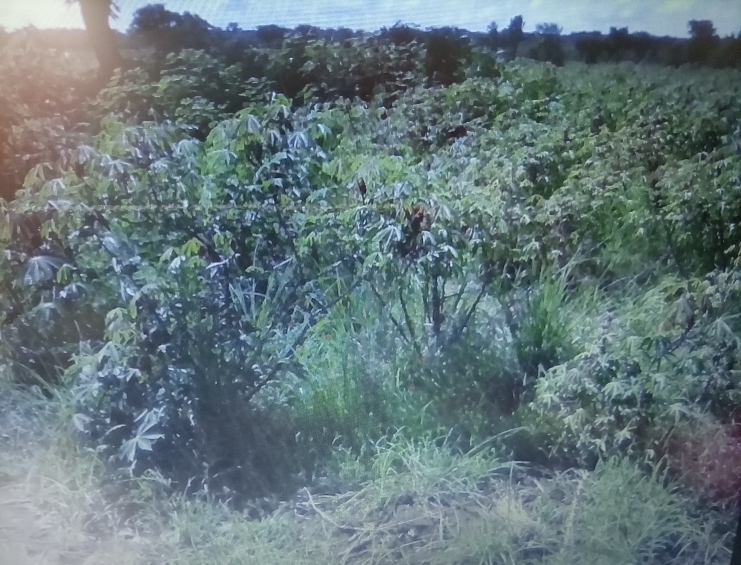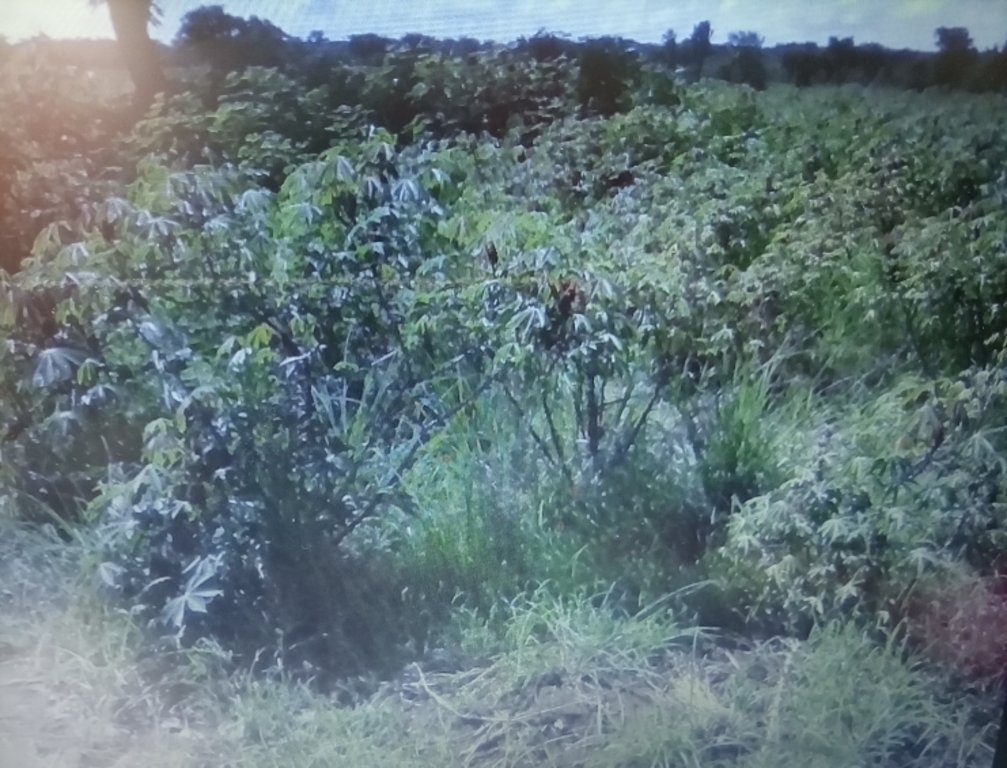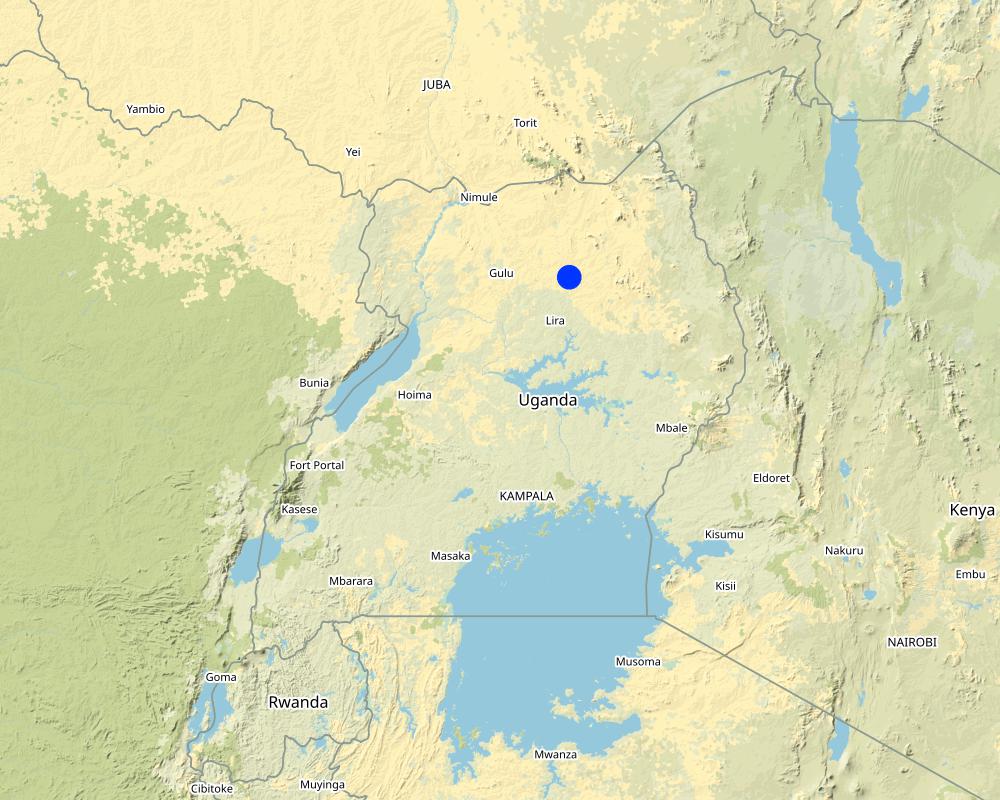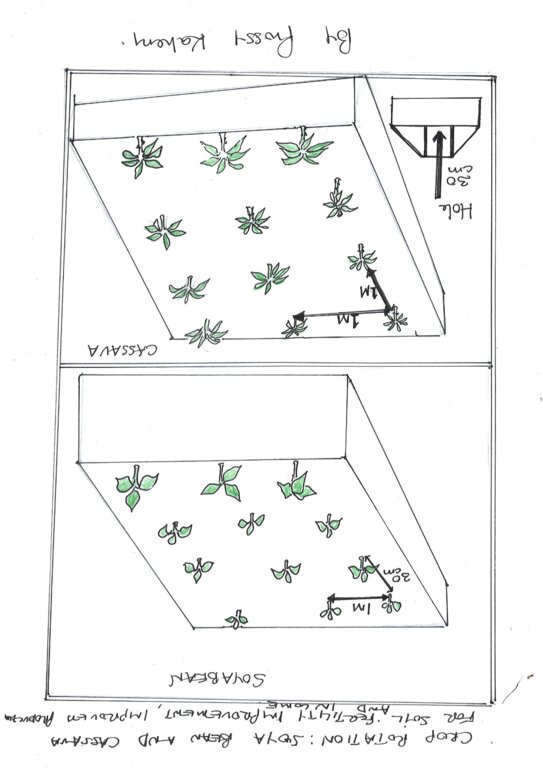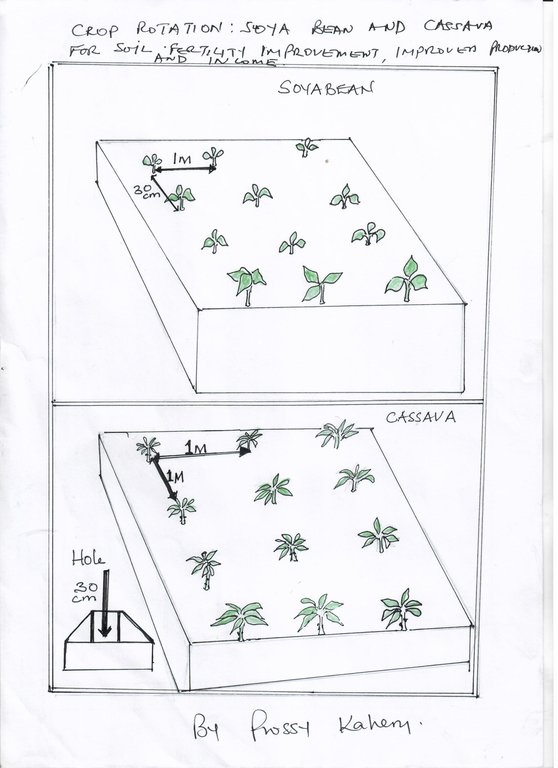Cassava-Soybean Crop Rotation for Soil Fertility Improvement, Improved Production, Income and Food Security [乌干达]
- 创建:
- 更新:
- 编制者: betty adoch
- 编辑者: JOY TUKAHIRWA, Kamugisha Rick Nelson, Bernard Fungo
- 审查者: Drake Mubiru, Nicole Harari, Stephanie Jaquet, Udo Höggel
Leno cam i poto
technologies_2707 - 乌干达
查看章节
全部展开 全部收起1. 一般信息
1.2 参与该技术评估和文件编制的资源人员和机构的联系方式
关键资源人
土地使用者:
Olal Levi
Agago District Local government
Arum village, Kazikazi Parish, Kazikazi Sub-County, Agago District.
乌干达
有助于对技术进行记录/评估的项目名称(如相关)
Scaling-up SLM practices by smallholder farmers (IFAD)有助于对技术进行记录/评估的机构名称(如相关)
Uganda Landcare Network (ULN) - 乌干达1.3 关于使用通过WOCAT记录的数据的条件
(现场)数据是什么时候汇编的?:
10/05/2017
编制者和关键资源人员接受有关使用通过WOCAT记录数据的条件。:
是
1.4 所述技术的可持续性声明
这里所描述的技术在土地退化方面是否存在问题,导致无法被认为是一种可持续的土地管理技术?:
否
注释:
Crop rotation enhances soil fertility due to its ability to maintain plant nutrients.
2. SLM技术的说明
2.1 技术简介
技术定义:
Crop rotation is a common practice used by farmers in northern Uganda. It involves the growing a series of different types of crops in the same field in sequential seasons to improve soil fertility, nutrition, income and food security .
2.2 技术的详细说明
说明:
With crop rotation, a crop that leaches the soil of one kind of nutrient is followed during the next growing season by a another crop that returns that nutrient to the soil or draws a different ratio of nutrients.
At the start of the season, soybean was planted on a gently sloping land in rows in a spacing of 1 meter between the rows and 30 cm between the plants. In the subsubsequent year, cassava tuber stems were cut at a length of 30 cm and planted in a hole of 30 cm depth and a spacing of 1 meter using the following required in puts: seed, hired labour, tractor, ox-plough, hoes and pangas (axes). This technology integrated as well the construction of trenches within the field for soil and water conservation.
The application of this technology increased crop yields as evidenced by the land user. Crop rotation mitigates as well the build up of pathogens and pests that often occur when one species is continuously cropped in the same location. Crop rotation improves soil structure and fertility by increasing subsoil biomass from various root structures. While promoting this practice, its important that the landuser plants as well legumes for nitrogen fixation after cropping a nitrogen depleting crop. Similarly, a low residue crop (i.e. a crop with low biomass) should be followed by a high biomass crop, like a mixture of grasses and legumes.
The application of this technology requires the land user to subdivide the land into different portions for different crops. Crops could be planted in the following manner: 1) Cereals crop with legumes, 2) Deep rooted with shallow rooted and a cover crop.
Important to note is that crop rotation is good at preventing soil depletion, maintaining soil fertility, reducing soil erosion, controlling insect/mite pests, reducing reliance on synthetic chemicals, reducing the pests' build-up and controlling weeds. On the other hand, crop rotation can be dangerous and may affect a following crop with diseases originating from the first crop.
2.3 技术照片
2.4 技术视频
注释、简短说明:
Video showing crop rotation farming systems of cassava planted with soybeans.
日期:
10/05/2017
位置:
Agago Sub County Headquarters
摄影师的名字:
Betty Adoch
2.5 已应用该技术的、本评估所涵盖的国家/地区/地点
国家:
乌干达
区域/州/省:
Agago District , Arum Sub-county, Kazikazi Parish , Arum Village.
有关地点的进一步说明:
Town council
注释:
The GPS coordinates shows the cassava field described in Agago District.
Map
×2.6 实施日期
注明实施年份:
2015
2.7 技术介绍
详细说明该技术是如何引入的:
- 通过土地使用者的创新
注释(项目类型等):
The cassava stems were obtained from Agago District Local Government supplied by Operation Wealth Creation (OWC).
3. SLM技术的分类
3.1 该技术的主要目的
- 改良生产
- 减少、预防、恢复土地退化
- 适应气候变化/极端天气及其影响
- 创造有益的经济影响
3.2 应用该技术的当前土地利用类型

农田
- 多年一作(非木材)
主要农作物(经济作物及粮食作物):
Cassava and soybean
如果由于技术的实施而导致土地用途发生变化,则在技术实施前说明土地利的用途。:
It was originally uncultivated land.
3.3 有关土地利用的更多信息
该技术所应用土地的供水:
- 雨养
每年的生长季节数:
- 1
具体说明:
Mostly cultivated during the wet season
3.4 该技术所属的SLM组
- 轮作制度(轮作、休耕、轮垦)
- 土壤肥力综合管理
3.5 技术传播
具体说明该技术的分布:
- 均匀地分布在一个区域
如果该技术均匀地分布在一个区域上,请注明覆盖的大致区域。:
- 0.1-1 平方千米
3.6 包含该技术的可持续土地管理措施

农艺措施
- A2:有机质/土壤肥力
- A5:种子管理,改良品种
3.7 该技术强调的主要土地退化类型

土壤水蚀
- Wt:表土流失/地表侵蚀
- Wg:冲沟侵蚀/沟蚀

土壤风蚀
- Et:表土流失
- Ed:风蚀风积
3.8 防止、减少或恢复土地退化
具体数量名该技术与土地退化有关的目标:
- 防止土地退化
- 减少土地退化
4. 技术规范、实施活动、投入和成本
4.1 该技术的技术图纸
作者:
Betty Adoch
日期:
10/05/2017
4.2 技术规范/技术图纸说明
Soybean was been planted on gentlly sloping land in rows in a spacing of 1 meter between the rows and 30 cm between the plants. In the subsubsequent year, cassava was planted. The tuber stems were cut at a length of 30 cm and planted in a hole of 30 cm depth and a spacing of 1 x 1 meter integrated with trenches for soil and water conservation.
4.3 有关投入和成本计算的一般信息
具体说明成本和投入是如何计算的:
- 每个技术区域
注明尺寸和面积单位:
43 acres
其它/国家货币(具体说明):
UGX
注明美元与当地货币的汇率(如相关):1美元=:
3500.0
注明雇用劳工的每日平均工资成本:
2500shs
4.4 技术建立活动
| 活动 | 措施类型 | 时间 | |
|---|---|---|---|
| 1. | Acquiring cassava stems from Operation Wealth Creation | 农业学的 | March |
| 2. | Clearing the land by tractor | 农业学的 | Late March |
| 3. | Planting using hired labour | 农业学的 | Early april |
4.5 技术建立所需要的费用和投入
| 对投入进行具体说明 | 单位 | 数量 | 单位成本 | 每项投入的总成本 | 土地使用者承担的成本% | |
|---|---|---|---|---|---|---|
| 劳动力 | Hired labour | acres | 10.0 | 2500.0 | 25000.0 | 100.0 |
| 设备 | Tractor | pice | 1.0 | 70000.0 | 70000.0 | 100.0 |
| 设备 | Ox-plough | pice | 1.0 | 17000.0 | 17000.0 | 100.0 |
| 设备 | Axes | pieces | 2.0 | 7000.0 | 14000.0 | 100.0 |
| 设备 | Pangas | pices | 2.0 | 10000.0 | 20000.0 | 100.0 |
| 设备 | Hoes | pieces | 5.0 | 10000.0 | 50000.0 | 100.0 |
| 植物材料 | Seeds | 1 | 100.0 | 5000.0 | 500000.0 | 100.0 |
| 技术建立所需总成本 | 696000.0 | |||||
4.6 维护/经常性活动
| 活动 | 措施类型 | 时间/频率 | |
|---|---|---|---|
| 1. | Weeding | 农业学的 | May |
| 2. | Establishing a fireline | 农业学的 | December |
注释:
There exists a risk of fire outbreaks in cassava cultivations.
4.7 维护/经常性活动所需要的费用和投入(每年)
| 对投入进行具体说明 | 单位 | 数量 | 单位成本 | 每项投入的总成本 | 土地使用者承担的成本% | |
|---|---|---|---|---|---|---|
| 劳动力 | Mans days for weeding for one month | 1 | 30.0 | 5000.0 | 150000.0 | 100.0 |
| 设备 | Hoe | Piece | 5.0 | 12000.0 | 60000.0 | 100.0 |
| 技术维护所需总成本 | 210000.0 | |||||
如果土地使用者负担的费用少于100%,请注明由谁负担其余费用:
no one
4.8 影响成本的最重要因素
描述影响成本的最决定性因素:
Seeds, tractor and labour hire.
5. 自然和人文环境
5.1 气候
年降雨量
- < 250毫米
- 251-500毫米
- 501-750毫米
- 751-1,000毫米
- 1,001-1,500毫米
- 1,501-2,000毫米
- 2,001-3,000毫米
- 3,001-4,000毫米
- > 4,000毫米
有关降雨的规范/注释:
Moderate rain during wet seasons from April to November.
注明所考虑的参考气象站名称:
Kitgum weather station
农业气候带
- 半湿润
Tropical savanna climate
5.2 地形
平均坡度:
- 水平(0-2%)
- 缓降(3-5%)
- 平缓(6-10%)
- 滚坡(11-15%)
- 崎岖(16-30%)
- 陡峭(31-60%)
- 非常陡峭(>60%)
地形:
- 高原/平原
- 山脊
- 山坡
- 山地斜坡
- 麓坡
- 谷底
垂直分布带:
- 0-100 m a.s.l.
- 101-500 m a.s.l.
- 501-1,000 m a.s.l.
- 1,001-1,500 m a.s.l.
- 1,501-2,000 m a.s.l.
- 2,001-2,500 m a.s.l.
- 2,501-3,000 m a.s.l.
- 3,001-4,000 m a.s.l.
- > 4,000 m a.s.l.
说明该技术是否专门应用于:
- 不相关
关于地形的注释和进一步规范:
Generally flat landscape.
5.3 土壤
平均土层深度:
- 非常浅(0-20厘米)
- 浅(21-50厘米)
- 中等深度(51-80厘米)
- 深(81-120厘米)
- 非常深(> 120厘米)
土壤质地(表土):
- 中粒(壤土、粉土)
土壤质地(地表以下> 20厘米):
- 中粒(壤土、粉土)
表土有机质:
- 中(1-3%)
5.4 水资源可用性和质量
地下水位表:
5-50米
地表水的可用性:
好
水质(未处理):
良好饮用水
水的盐度有问题吗?:
否
该区域正在发生洪水吗?:
否
5.5 生物多样性
物种多样性:
- 高
栖息地多样性:
- 高
5.6 应用该技术的土地使用者的特征
定栖或游牧:
- 定栖的
生产系统的市场定位:
- 混合(生计/商业
非农收入:
- 收入的10-50%
相对财富水平:
- 平均水平
个人或集体:
- 个人/家庭
机械化水平:
- 手工作业
- 畜力牵引
性别:
- 女人
- 男人
土地使用者的年龄:
- 中年人
- 老年人
5.7 应用该技术的土地使用者拥有或租用的平均土地面积
- < 0.5 公顷
- 0.5-1 公顷
- 1-2 公顷
- 2-5公顷
- 5-15公顷
- 15-50公顷
- 50-100公顷
- 100-500公顷
- 500-1,000公顷
- 1,000-10,000公顷
- > 10,000公顷
这被认为是小规模、中规模还是大规模的(参照当地实际情况)?:
- 中等规模的
5.8 土地所有权、土地使用权和水使用权
土地所有权:
- 个人,未命名
土地使用权:
- 个人
用水权:
- 社区(有组织)
5.9 进入服务和基础设施的通道
健康:
- 贫瘠
- 适度的
- 好
教育:
- 贫瘠
- 适度的
- 好
技术援助:
- 贫瘠
- 适度的
- 好
就业(例如非农):
- 贫瘠
- 适度的
- 好
市场:
- 贫瘠
- 适度的
- 好
能源:
- 贫瘠
- 适度的
- 好
道路和交通:
- 贫瘠
- 适度的
- 好
饮用水和卫生设施:
- 贫瘠
- 适度的
- 好
金融服务:
- 贫瘠
- 适度的
- 好
6. 影响和结论性说明
6.1 该技术的现场影响
社会经济效应
生产
作物生产
注释/具体说明:
Improved yields of cassava crop
作物质量
注释/具体说明:
Quality cassava tubers harvested due to abundant plant nutrients through crop rotation
收入和成本
农业投入费用
注释/具体说明:
Reduced expenses through crop rotation e.g. savings on mineral fertiliser due to the integration of legumes into the crop rotation system.
农业收入
注释/具体说明:
High income earned after sale of quality cassava obtained through crop rotation.
收入来源的多样性
SLM之前的数量:
low
SLM之后的数量:
high
注释/具体说明:
various sources of income
社会文化影响
食品安全/自给自足
注释/具体说明:
Crop rotation increases cassava yield which improves food security.
SLM/土地退化知识
注释/具体说明:
Good knowledge of crop rotation.
生态影响
水循环/径流
水的回收/收集
注释/具体说明:
Surface run-off controlled through active water collection measures.
土壤
养分循环/补给
注释/具体说明:
Crop rotation recycles plant nutrients into the soil.
生物多样性:植被、动物
害虫/疾病控制
注释/具体说明:
crop rotation controls the spread of pests and diseases
6.3 技术对渐变气候以及与气候相关的极端情况/灾害的暴露和敏感性(土地使用者认为的极端情况/灾害)
渐变气候
渐变气候
| 季节 | 气候变化/极端天气的类型 | 该技术是如何应对的? | |
|---|---|---|---|
| 年温度 | 增加 | 适度 | |
| 季节性温度 | 湿季/雨季 | 增加 | 适度 |
| 年降雨量 | 减少 | 适度 | |
| 季雨量 | 湿季/雨季 | 减少 | 适度 |
气候有关的极端情况(灾害)
气象灾害
| 该技术是如何应对的? | |
|---|---|
| 局地暴雨 | 适度 |
| 局地雹灾 | 适度 |
6.4 成本效益分析
技术收益与技术建立成本相比如何(从土地使用者的角度看)?
短期回报:
积极
长期回报:
积极
技术收益与技术维护成本/经常性成本相比如何(从土地使用者的角度看)?
短期回报:
积极
长期回报:
积极
6.5 技术采用
- 10-50%
如若可行,进行量化(住户数量和/或覆盖面积):
10 household
在所有采用这项技术的人当中,有多少人是自发地采用该技术,即未获得任何物质奖励/付款?:
- 50-90%
6.6 适应
最近是否对该技术进行了修改以适应不断变化的条件?:
是
若是,说明它适应了哪些变化的条件:
- 气候变化/极端气候
具体说明技术的适应性(设计、材料/品种等):
Crop rotation spectrum increased through incorporating maize into the rotation system.
6.7 该技术的优点/长处/机会
| 土地使用者眼中的长处/优势/机会 |
|---|
| Helps in controlling weeds thus improving productivity. |
| Good at providing income after sale of two crops. |
| Enhances maximum nutrients utilization. |
| 编制者或其他关键资源人员认为的长处/优势/机会 |
|---|
| Good at preventing depletion of nutrients hence, maintaining soil fertility. |
| Reduces soil erosion. |
| Reduces pest build-up therefore, reduces disease infestation. |
| Improves productivity and enhances maximum nutrients utilization. |
6.8 技术的弱点/缺点/风险及其克服方法
| 土地使用者认为的弱点/缺点/风险 | 如何克服它们? |
|---|---|
| The fungi and pests left behind from the a previous crop can potentially harm the new crop. | Liase with agronomist for advice on appropriate pesticides and fungicides to use. |
| More time is required in preparing fields for crop ahead of rotation. | Proper timing of farm operations in preparation of rotations. |
| 编制者或其他关键资源人员认为的弱点/缺点/风险 | 如何克服它们? |
|---|---|
| The fungi and pests left behind from the a previous crop can potentially harm the new crop. | Liase with agronomist for advice on appropriate pesticides and fungicides to use. |
| More time is required in preparing field for crop ahead of rotation. | Proper timing of farm operations in preparation of rotations. |
| May affect second with disease if the first crop was diseased. | Need for spraying before planting. |
7. 参考和链接
7.1 信息的方法/来源
- 实地考察、实地调查
1
- 与土地使用者的访谈
1
7.2 参考可用出版物
标题、作者、年份、ISBN:
Efforts by Small-Scale Farmers to Maintain Soil Fertility and Their Impacts on Soil Properties, Luwero District, Uganda, K.Nyombi, K.B.Ester and Jj.Y.K.Zake2018
可以从哪里获得?成本如何?
https://www.tandfonline.com/author/Zake%2C+J+Y+K
7.3 链接到网络上可用的相关信息
标题/说明:
Cropping systems and soil quality and fertility in south-central Uganda
URL:
Researchgate.net/publication/330101543_
链接和模块
全部展开 全部收起链接
无链接
模块
无模块


